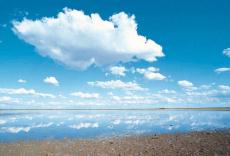 |
 |
 |
Other Health Topics:

-
Related Topics
-
Go Local
- Services and providers for Ozone in the U.S.
-
National Institutes of Health
- The primary NIH organization for research on Ozone is the National Institute of Environmental Health Sciences
Ozone is a gas. It can be good or bad, depending on where it is. "Good" ozone occurs naturally about 10 to 30 miles above the Earth's surface. It shields us from the sun's ultraviolet rays. Part of the good ozone layer is gone - destroyed by man-made chemicals. Without enough good ozone, people may get too much ultraviolet radiation. This may increase the risk of skin cancer, cataracts and immune system problems.
"Bad" ozone is at ground level. It forms when pollutants from cars, factories and other sources react chemically with sunlight. It is the main ingredient in smog. It is usually worst in the summer. Breathing bad ozone can be harmful, causing coughing, throat irritation, worsening of asthma, bronchitis and emphysema, and even permanent lung damage, if you are regularly exposed to it.
Environmental Protection Agency
-
Air Quality Guide for Ozone(Environmental Protection Agency) - Links to PDF
Also available in Spanish
-
Ozone and Your Health(Environmental Protection Agency)
Also available in Spanish
| Basics | Learn More | Multimedia & Cool Tools |
|---|---|---|
| Research | Reference Shelf | For You |
-
Overviews
-
Ozone
 (National Institute of Environmental Health Sciences)
(National Institute of Environmental Health Sciences)
- Ozone Fact Sheet(American Lung Association)
- Ozone: Good Up High, Bad Nearby(Environmental Protection Agency, Office of Air Quality Planning and Standards)
-
Tox Town
 (National Library of Medicine) - Requires Flash Player
(National Library of Medicine) - Requires Flash Player
Also available in Spanish
-
Ozone
-
Prevention/Screening
- Green Vehicle Guide(Environmental Protection Agency)
- What You Should Know about Refrigerants When Purchasing or Repairing a Residential Air Conditioning System or Heat Pump(Environmental Protection Agency)
- You Can Help Keep the Air Cleaner -- Every Day(Environmental Protection Agency)
-
Specific Conditions
- 8-Hour Ground-Level Ozone Designation FAQ's(Environmental Protection Agency)
- Brief Questions and Answers on Ozone Depletion(Environmental Protection Agency)
- Effects of Ozone Layer Depletion(Environmental Protection Agency)
- Ground-Level Ozone(Environmental Protection Agency, Office of Air Quality Planning and Standards)
-
Related Issues
- Effects of Ozone Pollution(American Association for Respiratory Care)
- Greenhouse Gases(National Oceanic and Atmospheric Administration)
- Ozone Air Purifiers: Can They Improve Asthma Symptoms?(Mayo Foundation for Medical Education and Research)
- Ozone Generators That Are Sold as Air Cleaners(Environmental Protection Agency, Indoor Environments Division)
-
Pictures & Photographs
- Ozone - Current Air Quality Index(Environmental Protection Agency)
- Process of Ozone Depletion(Environmental Protection Agency)
-
Clinical Trials
-
ClinicalTrials.gov: Ozone
 (National Institutes of Health)
(National Institutes of Health)
-
ClinicalTrials.gov: Ozone
-
Journal Articles
References and abstracts from MEDLINE/PubMed (National Library of Medicine)
- Article: Effects of exposure to 0.06 ppm ozone on FEV1 in...
- Article: Adverse cardiovascular effects with acute particulate matter and ozone exposures:...
- Article: Ambient ozone concentration and hospital admissions due to childhood respiratory...
- Ozone -- see more articles
-
Dictionaries/Glossaries
- Ozone Depletion Glossary(Environmental Protection Agency)
-
Organizations
- American Lung Association
- Environmental Protection Agency, Office of Air and Radiation
-
National Institute of Environmental Health Sciences

Also available in Spanish
-
Children
- Children and Ozone Air Pollution(American Lung Association)
-
Ozone, Air Quality, and Asthma(Nemours Foundation)
Also available in Spanish
- SunWise Kids: Ozone(Environmental Protection Agency)
-
Teenagers
- On the Trail of the Missing Ozone: The Causes, Effects, and Solutions to Ozone Depletion(Environmental Protection Agency)
-
Seniors
- Effects of Ozone Pollution on Seniors(American Academy of Allergy, Asthma, and Immunology)
| Home | Health Topics | Drugs & Supplements | Encyclopedia | Dictionary | News | Directories | Other Resources | |
| Copyright | Privacy | Accessibility | Quality Guidelines U.S. National Library of Medicine, 8600 Rockville Pike, Bethesda, MD 20894 National Institutes of Health | Department of Health & Human Services |
Date last updated: 05 August 2008 Topic last reviewed: 05 August 2008 |






